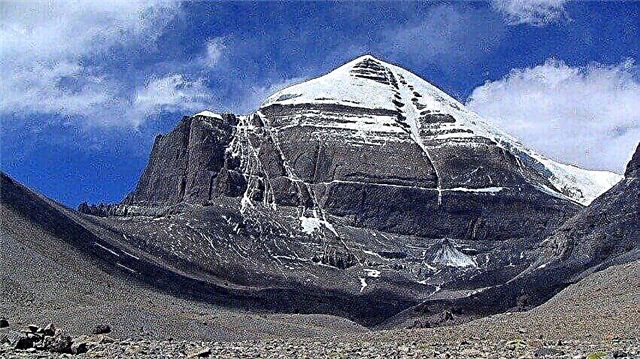The Earth's atmosphere is unique not only in its composition, but also in its importance for the appearance of the planet and the maintenance of life. The atmosphere contains oxygen necessary for breathing, retains and redistributes heat, and serves as a reliable shield from harmful cosmic rays and small celestial bodies. Thanks to the atmosphere, we see rainbows and auroras, admire beautiful sunrises and sunsets, enjoy the safe sun and snowy landscapes. The influence of the atmosphere on our planet is so multifaceted and all-encompassing that abstract reasoning about what would have happened if there was no atmosphere make no sense - simply in this case there would be nothing. Instead of speculative inventions, it is better to get acquainted with some properties of the earth's atmosphere.
1. Where the atmosphere begins, it is known - this is the surface of the Earth. But where it ends, one can argue. Air molecules are also found at an altitude of 1,000 km. However, the more generally accepted figure is 100 km - at this altitude, the air is so thin that flights using the lifting force of the air become impossible.
2. 4/5 of the weight of the atmosphere and 90% of the water vapor contained in it are in the troposphere - the part of the atmosphere located directly at the Earth's surface. In total, the atmosphere is conventionally divided into five layers.
3. Auroras are collisions of particles of the solar wind with ions located in the thermosphere (the fourth layer of the earth's gas envelope) at an altitude of more than 80 km.

4. The ions of the upper layers of the atmosphere, in addition to the demonstration of the aurora borealis, played a very important practical role. Before the advent of satellites, stable radio communication was provided only by multiple reflections of radio waves (and only with a length of more than 10 m) from the ionosphere and the earth's surface.
5. If you mentally compress the entire atmosphere to normal pressure at the Earth's surface, the height of such a gas envelope would not exceed 8 km.
6. The composition of the atmosphere is changing. Originating 2.5 billion years ago, it consisted mainly of helium and hydrogen. Gradually heavier gases pushed them into space, and ammonia, water vapor, methane and carbon dioxide began to form the basis of the atmosphere. The modern atmosphere was formed with its saturation with oxygen, which was released by living organisms. It is thus called tertiary.
7. The concentration of oxygen in the air changes with altitude. At an altitude of 5 km, its share in the air decreases by one and a half times, at an altitude of 10 km - four times from the normal at the planet's surface.
8. Bacteria are found in the atmosphere at altitudes up to 15 km. To feed at such a height, they have enough organic matter in the composition of the atmospheric air.
9. The sky does not change its color. Strictly speaking, it does not have it at all - the air is transparent. Only the angle of incidence of the sun's rays and the length of the light wave that are scattered by the components of the atmosphere change. A red sky at dusk or dawn is the result of particulate matter and water droplets in the atmosphere. They scatter the sun's rays, and the shorter the wavelength of light, the stronger the scattering. Red light has the longest wavelength, therefore, when passing through the atmosphere even at a very obtuse angle, it is scattered less than others.

10. Roughly the same nature and the rainbow. Only in this case, the light rays are refracted and scattered evenly, and the wavelength affects the scattering angle. Red light deflects by 137.5 degrees, and violet - by 139. These one and a half degrees are enough to show us a beautiful natural phenomenon and make us remember what every hunter wants. The top strip of the rainbow is always red and the bottom is purple.

11. The presence of our planet's atmosphere does not make the Earth unique among other celestial bodies (in the Solar system, the gas envelope is absent only in the closest to the Sun Mercury). The uniqueness of the Earth is in the presence of a large amount of free oxygen in the atmosphere and the constant replenishment of the planet's gas envelope with oxygen. After all, a huge number of processes on Earth take place with active consumption of oxygen, from combustion and respiration to rotting food and rusting nails. However, the oxygen concentration in the atmosphere remains relatively stable.
12. The contrails of jetliners can be used to predict the weather. If the plane leaves behind a thick, well-defined white stripe, then it is likely to rain. If the contrail is transparent and indistinct, it will be dry. It's all about the amount of water vapor in the atmosphere. It is they who, mixing with the engine exhaust, create a white trace. If there is a lot of water vapor, the contrail is denser and the probability of precipitation is higher.

13. The presence of the atmosphere significantly softens the climate. On planets devoid of atmosphere, the differences between night and day temperatures reach tens and hundreds of degrees. On Earth, these differences are impossible due to the atmosphere.
14. The atmosphere also serves as a reliable shield from cosmic radiation and solids arriving from space. The vast majority of meteorites do not reach the surface of our planet, burning up in the upper layers of the atmosphere.

15. The absolutely illiterate expression "ozone hole in the atmosphere" appeared in 1985. British scientists have discovered a hole in the ozone layer of the atmosphere. The ozone layer protects us from harsh ultraviolet radiation, so the public immediately sounded the alarm. The appearance of the hole was immediately explained by human activity. The message that the hole (located over Antarctica) appears every year for five months, and then disappears, was ignored. The only visible results of the fight against the ozone hole were the ban on the use of freons in refrigerators, air conditioners and aerosols and a slight decrease in the size of the ozone hole.









